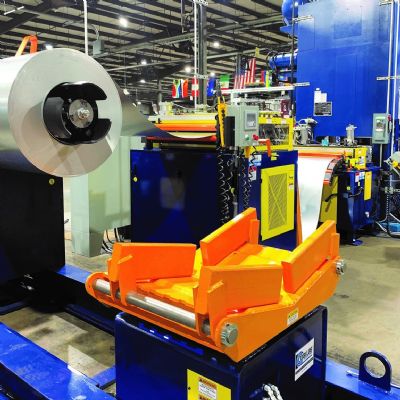The four master die sets:
- Expansion plugs (used to seal manufactured holes in castings) in a variety of styles and sizes. On board: two master dies with 100+ insert sets, to stamp more than 1000 diameter and material variations.
- Cup plugs (double-action master dies), including welch plugs, also used to seal holes; one master die, with dozens of insert sets.
- Compound dies (for stamping spring washers); six master dies using hundreds of previously produced inset sets.
- Progressive dies, including three new prog dies recently introduced to stamp furniture hardware. In all, five new prog dies with insert sets for other standard product lines.
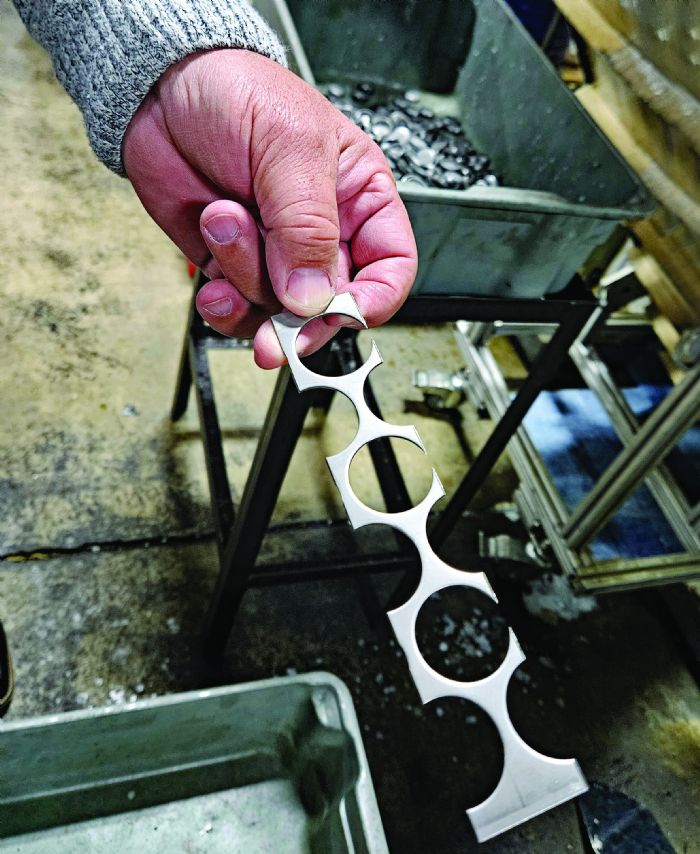 Also, to bring the project to fruition, the Hubbard team designed and fabricated custom hardware, including:
Also, to bring the project to fruition, the Hubbard team designed and fabricated custom hardware, including:
- Bolster plates with features for precise die positioning, scrap management and feed mounting
- Feed-mount plates for precision placement and stability, and for providing simplified height adjustments
- An additional PC with double screens on each servo-press cell for program management and other functions
- Custom developed chutes and conveyor systems for all use cases of part and scrap management.
Raw-Material Inventory Disappears
Expansion plugs, in a huge variety of sizes and material types, represent around 20% of the company’s business. They’re used in numerous engine applications including automotive, agriculture and cooling systems. Plug sizes range from ⅛- to 6-in. dia.
“Prior to the zig-zag feeds, we’d slit our own strips from wider coils, requiring us to carry a lot of raw-material inventory,” Nevin explains. “With the new feeds we’ve eliminated the slitting process completely, and gone from some 350 inventory items down to just 20 or 30.”
Adds Dawson: “We have so many part numbers for the huge variety of plugs … in the thousands. But some of these run in production only once every few years. So, I captured all of the various feed programs on Excel spreadsheets, and saved them on our server rather than on the feed-line control.
“Then, program management becomes the challenge,” he continues. “The feeders have a PLC at their core. I devised a process for communicating over the network from the server to the PLCs. And, I had to account for the fact that each feeder is designed to work independently and not on a network. So, I had to dig into the PLCs and change some settings to allow them to communicate over the network.
|
Founded in 1905 as the M.D. Hubbard Spring Co., in Pontiac, MI, the firm cut its teeth manufacturing leaf springs for buggies and harrow teeth for agricultural implements. Today, Hubbard Spring Co. works from a 40,000-sq.-ft. facility (circa 1973) in Oxford, MI. It stamps parts from strip 0.003 to 0.134 in. thick, as well as forms wire to ¼-in. dia. and tube to ¾-in. dia., from numerous metal alloys including copper and nickel alloys, cold-rolled and high-carbon steels, and stainless grades. Its abundant equipment/capabilities list includes stamping presses to 90 tons, fourslides and multislides, spring coilers, tube-cutting and deburring systems, production lathe turning, heat treating, tool design and build, plating and parts finishing, and welding. |
“And,” Dawson adds, “we’re working with Komatsu to incorporate its VIS (Visual Inspection System), which eventually will allow us to monitor on the press control the actual working loads (total/left and right) and slide position for each press.”
Digital stamping indeed!
State-of-the-Art Feeding
Explaining the zig-zag feed’s operation, P/A North American sales manager Don Frank says, “The feed creates a nested product along the width of the coil. The nest at Hubbard is five-out, almost linear—inline but staggered back and forth, with an index down. It’s the first time we’ve engineered a feed profile like this, a multi-out with staggered feed. It allows Hubbard to really optimize strip width and material yield.
“Oh, and by the way,” Frank adds, “of all of our customers, I’m only aware of one or two others that have accomplished what Hubbard has … and not to this extent.”
The Results?
“The real purpose of the project was to better organize our workflow,” Nevin shares. “While we’ve always performed custom progressive-die stamping, the goal was to have single pathways to run all types of parts, with optimum flexibility and versatility. We’ve even moved a lot of four-slide work over to prog dies.
“Two of the Komatsu servo presses run the master dies designed to handle all of the expansion plugs,” he continues. “And, our prog dies are engineered to the standards of those presses as well. We built all of new die shoes and kept the retainers, so everything we stamp can run in these presses. Our press utilization has gone up considerably as a result. That, in turn, helped us justify the investment in the zig-zag feeds.
“Bottom line,” Nevin wraps up, “we’re now processing all of our stampings in four presses running full time, replacing 12 presses that used to run sporadically. That translates into less labor needed to tend to our pressroom operations. We’re four times more efficient on labor using the master dies, and two times more efficient on prog-die stamping. Material utilization is up, setup times are averaging 20 min. compared to 1 hr. or more, and inventory-carrying costs are way down.” MF
View Glossary of Metalforming Terms
See also: Komatsu America Industries, LLC Press Technology Division, P/A Industries, Inc.
Technologies: Coil and Sheet Handling, Stamping Presses
Comments
Must be logged in to post a comment. Sign in or Create an Account
There are no comments posted.Feed-Release Timing—What Every Press Technician Should Know
Peter Ulintz September 20, 2024
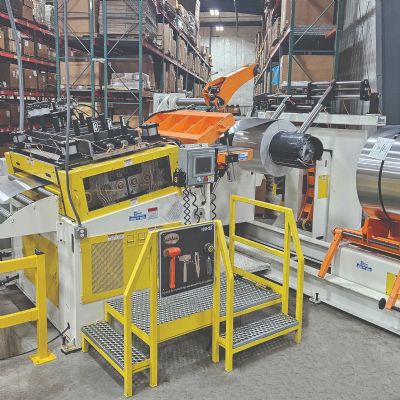 Coil and Sheet Handling
Coil and Sheet HandlingDallas Industries Delivers Another Feed Line to Manitowoc To...
August 28, 2024
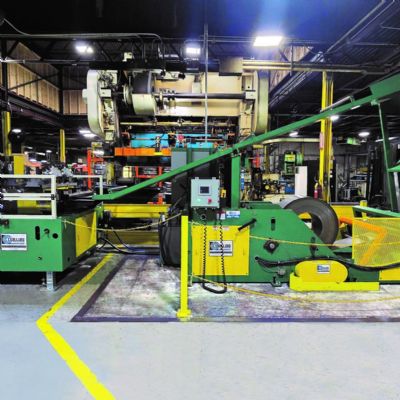 Coil and Sheet Handling
Coil and Sheet HandlingDallas Industries Delivers Feed Line to ODM Tool & Manufactu...
Wednesday, July 9, 2025







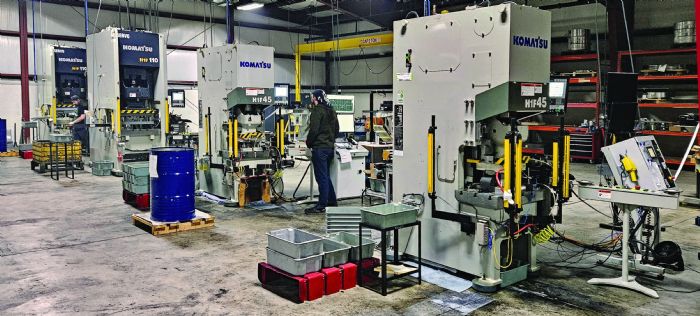 New in the shop: four Komatsu servo presses (two rated at 110 tons and two at 45 tons), equipped with P/A Industries’ zig-zag feed lines. Also key to the project: implementation of four sets of modular tooling that “radically reduce setup times,” says Nevin Hubbard, “and allow for easier training and shorter time to qualify new production and setup people.”
New in the shop: four Komatsu servo presses (two rated at 110 tons and two at 45 tons), equipped with P/A Industries’ zig-zag feed lines. Also key to the project: implementation of four sets of modular tooling that “radically reduce setup times,” says Nevin Hubbard, “and allow for easier training and shorter time to qualify new production and setup people.”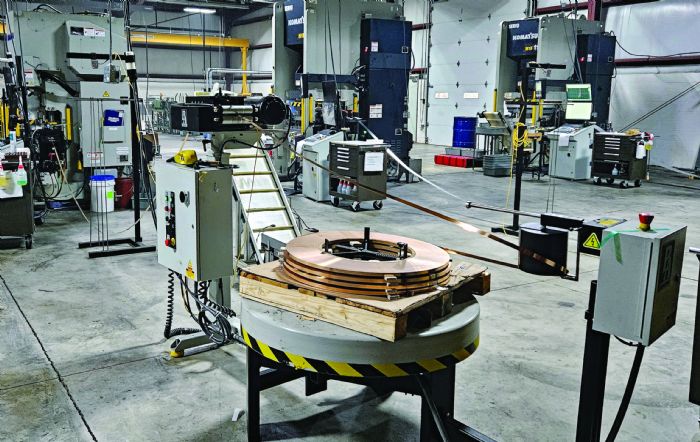 “With zig-zag stagger feeding, we’ve reduced the number of inventoried raw-material items from hundreds to a few dozen,” Nevin says. “And, for three of the four master die-set categories, we’ve improved material use by at least 12%.”
“With zig-zag stagger feeding, we’ve reduced the number of inventoried raw-material items from hundreds to a few dozen,” Nevin says. “And, for three of the four master die-set categories, we’ve improved material use by at least 12%.”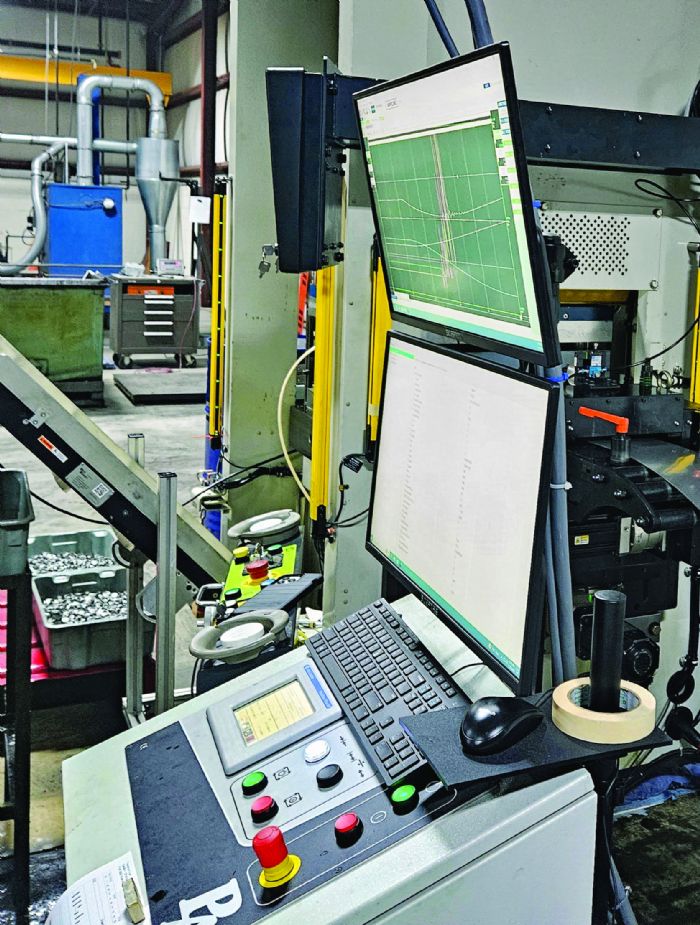 Dawson explains: “When we brought in these new press lines we sought to store all of the feed programs—which number in the thousands—offline, and develop a process for the operators to pull the programs down as needed to the production floor,” he says. “This helps us to maintain complete control of the programs away from the operations, ensuring consistency from run to run. And, all four servo presses have the same shut height, which helps to optimize scheduling flexibility.”
Dawson explains: “When we brought in these new press lines we sought to store all of the feed programs—which number in the thousands—offline, and develop a process for the operators to pull the programs down as needed to the production floor,” he says. “This helps us to maintain complete control of the programs away from the operations, ensuring consistency from run to run. And, all four servo presses have the same shut height, which helps to optimize scheduling flexibility.”